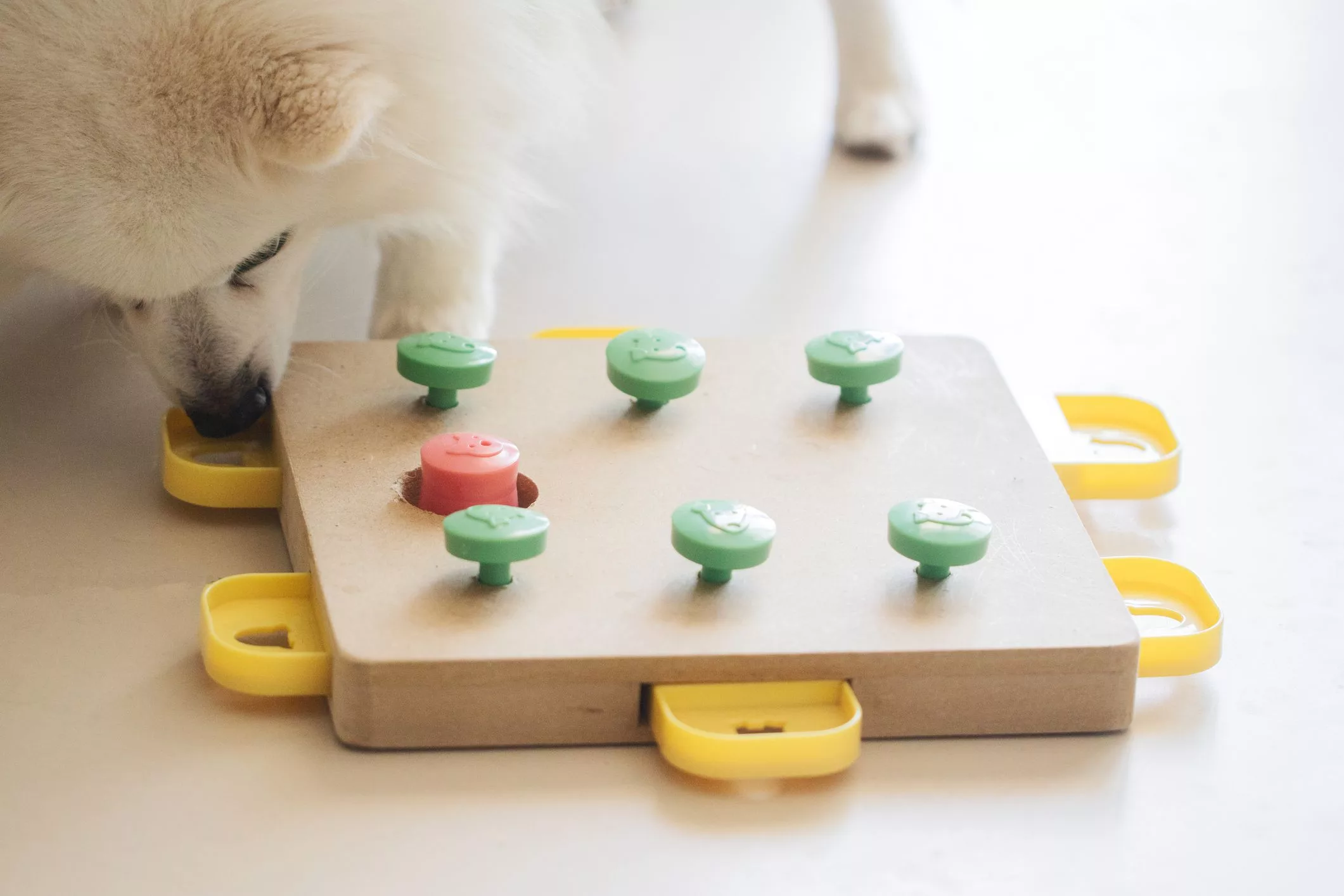Introduction 🐕
Indoors with dog activities provide a wonderful opportunity for bonding, exercise, and mental stimulation, especially when outdoor options are limited. In this guide, we’ll explore a variety of engaging and entertaining indoor activities to keep your canine companion happy and healthy while you’re both cozy inside your home. Whether it’s a rainy day, cold weather, or you simply want to have fun indoors, these activities will help you make the most of your time together with your furry friend.Here are five fun and creative indoor activities to keep your energetic dog entertained.
fun and creative activities to do indoors with dog.
1.Indoor Obstacle Course:

Create an obstacle course using pillows, chairs, and household items. Guide your dog through tunnels, over hurdles, and around obstacles. This engages their mind and burns off energy.
Here’s how to set up a simple one:
- Clear a Space: Start by clearing a designated area in your home. This could be a living room, hallway, or any space with enough room for your dog to move around safely.
- Gather Supplies: Collect items like pillows, cushions, cardboard boxes, chairs, and blankets. These will serve as the building blocks for your obstacle course.
- Design the Course: Arrange the items to create obstacles. For example, you can set up a tunnel using chairs and blankets, create a hurdle with pillows, or place cardboard boxes for your dog to jump over or weave through.
- Guide Your Dog: Use treats or their favorite toy to guide your dog through the course. Start with simple obstacles and gradually make it more challenging as your dog becomes comfortable.
- Encourage and Praise: Offer plenty of encouragement and praise when your dog successfully navigates each obstacle. Positive reinforcement will make the activity more enjoyable for them.
- Safety First: Ensure that the course is safe and stable. Avoid any items that could potentially harm your dog, and supervise them closely during the activity.
- Variety: Change the course layout and obstacles to keep it interesting for your dog. This will prevent boredom and provide ongoing mental and physical exercise.
Indoor with dog obstacle courses are a great way to bond with your dog and keep them entertained, especially when outdoor activities are limited. Have fun and get creative with the obstacles!
2.Hide and Seek:

Hide treats or toys in different rooms, and encourage your dog to find them using their sense of smell. This game provides mental stimulation and a playful challenge.
Playing hide and seek with your dog is not only fun but also a great way to engage their natural hunting instincts.
Here’s how to play:
- Start with Basics: Begin in a room where your dog can’t see you, and make sure your dog understands basic commands like “sit” and “stay.”
- Hide and Command: While your dog is in a “stay” position, find a hiding spot in the same room or in an adjacent room. Make sure it’s a place where your dog can eventually find you.
- Call Your Dog: Once you’re hidden, call your dog using an excited and playful voice. You can say something like “Come find me!” or “Where am I?”
- Let Them Seek: Release your dog from the “stay” command and let them search for you. Use their name or encouraging words to guide them if needed.
- Reward and Praise: When your dog finds you, reward them with treats, enthusiastic praise, and petting. Make it a joyful reunion.
- Repeat and Vary: Continue to play, gradually making the game more challenging. You can hide in different spots, use different rooms, or even involve other family members to hide and be found.
- Stay Patient: If your dog has trouble finding you at first, don’t worry. Be patient and help guide them with your voice until they get the hang of it.
Hide and seek is a mentally stimulating game that taps into your dog’s natural curiosity and tracking abilities. It’s also a great way to reinforce their recall command and strengthen your bond.
3.Puzzle Toys and Treat Dispensers:

Use puzzle toys or treat-dispensing balls to challenge your dog’s problem-solving skills. These toys require them to figure out how to get the treats out, keeping them occupied for a while.
Puzzle toys and treat dispensers are excellent tools to mentally stimulate and entertain your energetic dog.
Here’s how to use them effectively:
- Choose the Right Toy: Select a puzzle toy or treat dispenser that matches your dog’s size, skill level, and treat preferences. There are various options available, from simple treat balls to more complex puzzle feeders.
- Fill with Treats: Place some of your dog’s favorite treats or kibble inside the toy. Make sure it’s not too difficult for your dog to initially retrieve the treats, especially if they’re new to these toys.
- Introduce the Toy: Show the toy to your dog and let them sniff it. Encourage them to engage with it by rolling it or manipulating it with their paws.
- Supervise Initially: Especially when introducing a new puzzle toy, it’s a good idea to supervise your dog to ensure they don’t become frustrated. Help them figure out how to get the treats by gently demonstrating.
- Increase Complexity: As your dog becomes more skilled, you can use more challenging toys that require more effort to dispense treats. This keeps them mentally engaged.
- Mealtime Fun: You can use puzzle toys during mealtime to slow down your dog’s eating and make it more enjoyable. Instead of a regular bowl, use a treat-dispensing toy to dispense their kibble.
- Rotate Toys: Keep your dog’s interest by rotating their puzzle toys regularly. This prevents boredom and ensures they don’t get too accustomed to one toy.
- Safety First: Always supervise your dog when they’re playing with puzzle toys, especially if the toy has small parts that could be chewed off.
Puzzle toys and treat dispensers are not only entertaining but also provide mental stimulation and can help prevent destructive behavior by keeping your dog’s mind occupied.
4.DIY Agility Course:

Set up a DIY agility course using cardboard boxes, cones, and other items. Teach your dog to weave between obstacles, jump over low hurdles, and more.
Creating a DIY agility course for your dog indoors can be a fun and engaging way to help them burn off energy and improve their agility skills.
Here’s how to set up a simple one:
- Choose a Space: Pick a spacious area in your home, such as a living room, garage, or basement, where you have enough room to set up obstacles and for your dog to move around safely.
- Gather Supplies: Collect materials for your agility course. Some basic items you might need include:
- Cones or small traffic cones
- PVC pipes or broomsticks
- Hula hoops
- Cushions or pillows
- Tunnels (you can use blankets or large cardboard boxes)
- Small jumps (you can use cardboard boxes as low jumps)
- Set Up the Course: Arrange your chosen obstacles in a way that creates a circuit or course. Here are some ideas:
- Use cones or PVC pipes to create weave poles for your dog to zigzag through.
- Set up a tunnel using blankets draped over chairs or a large cardboard box with both ends open.
- Create small jumps by placing broomsticks or cardboard boxes at different heights.
- Place hula hoops on the ground for your dog to jump through.
- Introduce Your Dog: With your dog on a leash, guide them through each obstacle, using treats and positive reinforcement to encourage them. Start with one obstacle at a time to help them get comfortable.
- Practice and Encourage: Gradually work your way through the entire course, rewarding your dog with treats and praise for each successful obstacle. Be patient and keep training sessions short and positive.
- Increase Difficulty: As your dog becomes more proficient, you can make the course more challenging. Add more obstacles, increase the height of jumps, or change the order of obstacles to keep things interesting.
- Safety First: Always prioritize safety. Ensure that all obstacles are stable, and supervise your dog closely during agility training to prevent accidents.
DIY agility courses provide both physical exercise and mental stimulation for your dog while strengthening the bond between you. They’re a great way to have fun indoors, especially on rainy or snowy days when outdoor play isn’t possible.
5.Scent Work:

Scent work, also known as nose work, is an engaging and mentally stimulating activity for dogs. It taps into their natural sense of smell and provides both mental and physical exercise.
Here’s how to set up a scent work activity for your dog:
- Gather Supplies: You’ll need a few items to get started:
- Small, tasty treats or your dog’s favorite toy
- Scented cotton balls or a specific scent source (e.g., a small container with holes containing a strong-smelling treat)
- A designated search area (a room or part of a room where you can hide the scent source)
- Introduce the Scent: Let your dog sniff the scent source (e.g., scented cotton ball) and become familiar with the scent. This scent should be something your dog is interested in, like a treat.
- Hide the Scent: While your dog is out of the room or in another area, hide the scent source in the designated search area. Start with an easy hiding spot initially, and as your dog becomes more skilled, you can make it more challenging.
- Start the Search: Bring your dog to the search area and encourage them to use their nose to find the hidden scent source. Use phrases like “Find it!” or “Search!” to cue them. Be patient and let them explore.
- Reward and Praise: When your dog finds the hidden scent, reward them with treats or playtime using their favorite toy. Make the reward exciting to reinforce the idea that finding the scent is a fun and rewarding activity.
- Increase Difficulty: As your dog becomes more proficient, make the game more challenging by hiding the scent source in harder-to-reach places or by adding distractions.
- Multiple Hiding Spots: You can make the game even more interesting by hiding multiple scent sources in different locations within the search area. This encourages your dog to use their nose and problem-solving skills.
- Safety and Supervision: Always supervise your dog during scent work, especially if they tend to chew on or eat items they find. Ensure that the hiding spots are safe and free from potential hazards.
Scent work is a fantastic way to engage your dog’s mind and provide mental enrichment. It’s especially beneficial for dogs of all ages and abilities, including those with limited physical activity options. Plus, it’s a great bonding activity for you and your furry friend.

Engage your dog’s nose by hiding treats or their favorite toy in various places around the house. Encourage them to search and find the hidden items using their sense of smell.
Remember to tailor these activities to your dog’s abilities and preferences, and always ensure their safety during playtime.
What is celiac disease? and 100%complete treatment.





